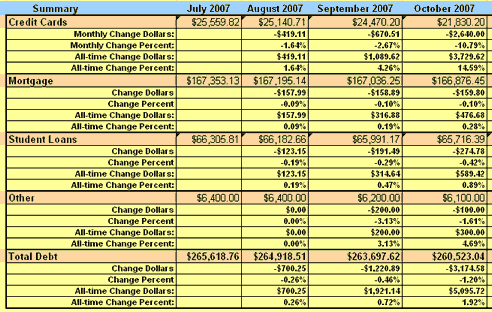No matter how well you have done with budgeting, cutting your spending, and tracking everything it is extremely easy to get bogged down in the daily grind and feel like you aren’t getting anywhere. I believe this is the hardest part of the process. Depending on the size of your debt balance and the size of your income, you could be looking at years to get out of debt, maybe decades.
There are essentially two levels of debt freedom. One is obvious- having no debt at all. The other is being debt free except for the mortgage. This distinction is made because a mortgage is generally thought of as good debt (I don’t agree, at least not on a long term basis), but saving up the cash to pay for a house is rather difficult and most of us end up with a mortgage when we want to own a home. I want to be 100% debt free and that is my goal, but I will feel a lot better about my debt load once I am debt free except for the mortgage.
Right now, seeing my debt balance gives me a sickening feeling deep down and really motivates me to work hard at getting out of debt. I don’t know if that feeling will go away when I am down to just a mortgage (frankly I hope it does not), but some of the pressure should be off by that time. That pressure and sickening feeling can both motivate you and discourage you. You need to recognize that you have these feelings and think about why you feel that way and what you need to do to change your situation. Nothing will improve if you don’t take action to improve it.
You really need to think about what being debt free means to you and most importantly what it means to you in the long term. For me, being debt free is about freedom. Freedom to not take a job because I need the money and it is a tolerable way to pay the bills. I don’t want to settle for that, but at this point in my life I need to make that choice. I have so much debt that I need my ‘day job’ plus extra work to make my way out of debt.
Don’t get all fired up and work hard for a month and then fizzle out. That is exactly how I have started just about every life changing process I have ever attempted in the past. It’s scary to say things are different this time, but things really are different this time. I am going slowly and making real habit changes. Not superficial changes that only last a short while. You can’t succeed by doing that. You need to go slowly, you need to make small changes that you can handle, and you need to maintain those changes. The steps you take toward becoming debt free need to become habits, natural parts of your life that you live on a daily basis. You need a solid foundation. That is why you should go slowly. Don’t expect to get out of debt overnight. Think about how long it took you to get into debt and allow plenty of time to get out.
In this Get Out of Debt Series, I have outlined many tools and methods for making a successful financial turnaround. I believe this series can be the solid foundation you use to support your journey out of debt. Everything I have talked about here is exactly what I am doing and I know that it works. I know that it is now only a matter of time until I am done with debt. Start your journey today and please feel free to post comments on this site or contact me via email if you need help or encouragement along the way.
9 Steps to Get Out of Debt
- # 1 Stop Borrowing Money
- # 2 (a) Why You Should Make a Budget
- # 2 (b) How to Make a Budget
- # 3 Turn Your Junk Into Cash
- # 4 Create an Emergency Fund
- # 5 Live Below Your Means
- # 6 Track Your Spending and Update Your Budget
- # 7 Visual Reminders to Track Your Debt
- # 8 Make Yourself Accountable
- # 9 Be Patient and Don’t Give Up
